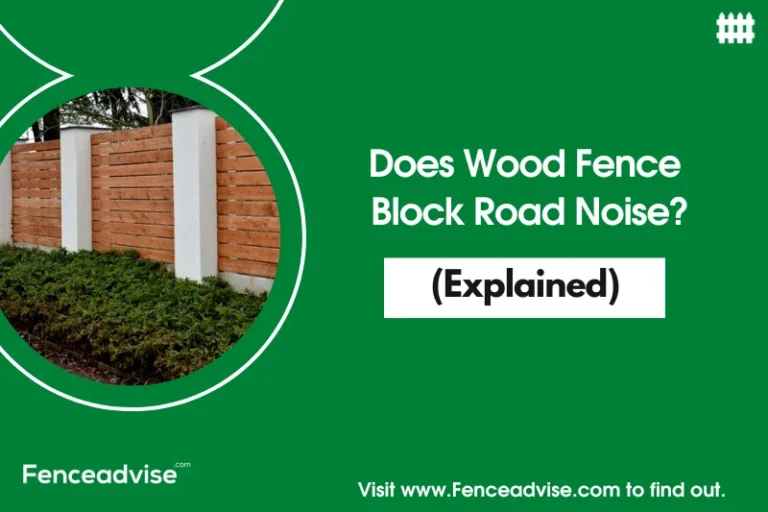We include products we think are useful for our readers. If you buy through links on this page, we may earn a small commission. Read our affiliate disclaimer here.
Dealing with warped fence boards can be a frustrating experience for any homeowner. Not only do they compromise the aesthetic appeal of your fence, but they can also affect its functionality and overall structural integrity.
Warping can occur due to various factors such as moisture, temperature changes, and age. Fortunately, there are effective methods to fix warped fence boards and restore the beauty and functionality of your fence.
In this article, we will guide you through the step-by-step process of fixing warped fence boards, providing you with practical solutions to address this common pain point. Let’s explore how you can revive your fence and enjoy a sturdy and visually appealing boundary once again.
Key Takeaways
Can You Fix A Warped Fence?
Yes, you can fix a warped fence. A warped fence is a common issue that can occur over time due to exposure to moisture, changes in temperature, or improper installation. However, with the right tools and techniques, you can rectify the problem and restore your fence to its original shape and functionality.
Get Matched with Local Fence Professionals
Answer a few questions and we’ll put you in touch with pros near you.
How Does Warping Of Wood Fence Occur?
Moisture
Wood is highly susceptible to changes in moisture content. When exposed to excessive moisture or drastic fluctuations in humidity, wood absorbs or releases water, causing it to expand or contract unevenly. This non-uniform movement leads to warping. To prevent moisture-related warping, it’s essential to properly dry and acclimate wood before use and protect it from prolonged exposure to water or high-humidity environments.
Temperature changes
Wood is also sensitive to temperature variations. When subjected to extreme heat or cold, wood expands or contracts. If the expansion or contraction is not uniform across the wood surface, it can result in warping. This is why proper seasoning and choosing stable wood species are important, as they are less prone to warping due to temperature changes.
Improper storage
Incorrect storage of wood, such as leaving it in direct sunlight or in damp areas, can contribute to warping. Exposure to sunlight can cause uneven drying, while damp conditions promote moisture absorption. Storing wood in a well-ventilated, dry environment, preferably off the ground, helps minimize warping.
Improper installation
Incorrect installation techniques can lead to wood warping over time. Inadequate fastening, insufficient support, or improper spacing between boards can create stress points and uneven pressure on the wood, resulting in warping. It’s crucial to follow proper installation guidelines and use appropriate fasteners to maintain the structural integrity of wood applications.
Natural characteristics of wood
Wood is an organic material with inherent structural properties. Variations in grain patterns, knots, and growth rings can cause differential expansion or contraction, leading to warping. Understanding the natural characteristics of the wood species you are working with can help you anticipate and minimize potential warping issues.
Age and deterioration
As wood ages, it becomes more susceptible to warping. Continuous exposure to environmental elements, such as sunlight, moisture, and pests, can degrade the wood’s structural integrity, making it more prone to warping. Regular maintenance, including sealing, staining, or painting, can help protect the wood and delay the onset of warping.
While some warping may still occur naturally, taking proactive steps can help mitigate the severity and extent of the warping, ensuring the longevity and functionality of your wood projects.
Methods to Repair Warped Wood Fences
To fix a warped fence, you’ll need to assess the extent of the warping and determine the best approach for correction. Here are some methods you can use:
- Wetting and Weighting: Wet the warped section of the fence board and apply weight to help it regain its shape. Leave the weights in place until the wood dries completely.
- Heat and Pressure: Apply heat to the warped area to make the wood pliable, then use pressure to straighten it. Secure the board in the desired position until it cools and hardens.
- Board Replacement: If the warping is severe or persistent, it may be necessary to replace the warped board with a new one that matches the existing fence.
Talk to a Fence Contractor Near You
How Do You Repair A Warped Wood Fence?
Method 1: Wetting and Weighting
Step 1: Assess the Warped Area
Identify the specific sections of the fence board that are warped. Determine the extent of the warping and whether it affects the overall stability of the fence.
Step 2: Wet the Warped Area
Thoroughly wet the warped section of the fence board with water. Use a hose or a sponge soaked in water to ensure the wood becomes damp. Allow the water to penetrate the wood fibers.
Step 3: Apply Weight
Place heavy objects on top of the warped section to exert pressure and help it regain its original shape. Concrete blocks, large rocks, or sandbags can be used as weights. Distribute the weights evenly along the length of the warped area.
Step 4: Let it Dry
Leave the weights in place until the wood dries completely. This process may take several days. The drying process allows the wood fibers to expand and contract, helping to straighten the fence board.
Method 2: Heat and Pressure
Step 1: Prepare the Work Area
Ensure the work area is clear and safe. Use caution when working with heat sources to avoid any fire hazards. Wear protective gloves and safety goggles.
Step 2: Apply Heat
Use a heat gun or a hairdryer set to a high temperature. Begin applying heat to the warped area, moving the heat source back and forth over the affected section. Heat the wood until it becomes pliable. Be careful not to overheat the wood, as it may lead to scorching or damage.
Step 3: Straighten the Board
Once the wood is heated and pliable, apply pressure to straighten the warped section. Use clamps, a vise, or heavy-duty straps to hold the board in the desired position. Ensure the pressure is evenly distributed along the warped area.
Step 4: Maintain Pressure until Cool
Keep the pressure applied until the wood cools down and hardens. This may take some time, so be patient and avoid moving or disturbing the board prematurely. The pressure helps the wood retain its corrected shape as it cools and hardens.
Method 3: Board Replacement
Step 1: Identify the Warped Board
Determine which board or boards are severely warped and affecting the overall stability of the fence. Assess if the warping can be corrected or if replacement is necessary.
Step 2: Remove the Warped Board
Carefully remove the warped board by unscrewing or prying out the nails or screws that hold it in place. Use caution to avoid damaging surrounding boards or the fence structure.
Step 3: Install a New Board
Select a replacement board that matches the style and dimensions of the existing fence. Attach the new board securely to the fence structure using appropriate nails or screws. Ensure the replacement board is straight and aligned with the surrounding boards.
Step 4: Finishing Touches
Inspect the newly replaced board and make any necessary adjustments. Check that it is securely fastened and blends well with the rest of the fence. Make sure to treat or seal the new board, if needed, to protect it from weathering and prolong its lifespan.
How To Prevent Warping Of Wood Fences in the Future?
To prevent the warping of a wood fence in the future, it’s important to take proactive measures during installation and maintenance. Here are some tips to help you prevent warping:
- Choose High-Quality Wood: Opt for high-quality, pressure-treated or naturally durable wood species for your fence. These types of wood are more resistant to warping and decay, ensuring a longer lifespan for your fence.
- Properly Seal or Stain the Wood: Apply a protective sealant or stain to the wood fence to help minimize moisture absorption. A quality sealant or stain will create a barrier that prevents water penetration, reducing the likelihood of warping.
- Allow for Proper Air Circulation: Ensure there is adequate space between the fence boards during installation. This allows for proper air circulation, which helps the wood dry more efficiently and reduces the risk of warping.
- Regularly Maintain and Inspect the Fence: Conduct regular inspections of your fence to identify any signs of warping or damage early on. Address any issues promptly to prevent them from worsening. Regular maintenance, such as cleaning, sealing, and painting, can also help protect the wood and minimize warping.
- Avoid Overexposure to Moisture: Minimize direct contact between the wood and excessive moisture sources. Avoid sprinklers hitting the fence directly or planting vegetation too close to the fence, as they can trap moisture against the wood and lead to warping.
- Properly Space Fence Posts: Ensure that the fence posts are properly spaced and securely installed. Properly spaced posts provide stability and support for the fence, reducing the risk of warping or sagging over time.
- Avoid Extreme Temperature Changes: Extreme temperature fluctuations can cause wood to expand and contract, leading to warping. Consider the climate in your area when choosing a wood species and take precautions to protect the fence from temperature extremes, such as providing shade or insulation.
- Regularly Check and Adjust Gate Hardware: Gate hardware can contribute to warping if not properly maintained. Regularly check and adjust gate hardware to ensure smooth operation and proper alignment, minimizing stress on the fence boards.
Can You Straighten Warped Fence Panels?
Yes, it is possible to straighten warped fence panels with the right approach and tools. Warping of fence panels can occur due to various factors such as changes in temperature, moisture exposure, improper installation, or natural aging of the wood. When confronted with warped fence panels, you have several methods at your disposal to help restore them to their original straight shape.
Conclusion
Dealing with warped fence boards and panels is a common challenge for homeowners. However, with the right knowledge and techniques, you can effectively address and rectify this issue. Whether through wetting and weighting, applying heat and pressure, or replacing severely warped panels, you have options for straightening and restoring your fence to its original shape.
Furthermore, taking preventive measures to minimize future warping, such as selecting high-quality wood, proper sealing, regular maintenance, and considering environmental factors, can help prolong the lifespan and integrity of your wood fence. By following these steps and being proactive, you can enjoy a sturdy and visually appealing fence for years to come.
At FenceAdvise, we pride ourselves on being the most reliable and trustworthy source of fencing information. Our articles are based on only the highest quality sources, including peer-reviewed studies, to ensure that our readers always have access to accurate information. Read more about our Editorial Guidelines, About Us.








